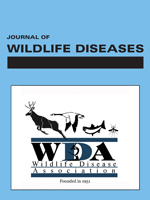Island foxes (Urocyon littoralis) are endemic to six of the eight California Channel Islands (USA). The island fox is classified as a threatened species by the State of California, and recently three of the six subspecies have experienced abrupt population declines. As part of a continuing effort to determine the cause of the declines, we tested island fox serum samples collected in 1988 (n = 176) and 1997–98 (n = 156) over the entire geographic range of the species for seroprevalence of canine heartworm (Dirofilaria immitis) antigen. Using a commercially available enzyme-linked immunosorbent assay (PetChek®, Idexx Laboratories, Westbrook, Maine, USA) we detected heartworm antigen in four of the six populations of island foxes. On San Miguel and Santa Rosa Islands, seroprevalence in adult foxes was >85% (n = 62) in 1988 and increased to 100% (n = 24) in 1997–98. On Santa Cruz Island, seroprevalence in adult foxes decreased from 83% (n = 30) to 58% (n = 26), whereas on San Nicolas Island, seroprevalence increased from 25% (n = 32) to 77% (n = 30) during the same period. All of the pups assayed (n = 33) were seronegative. The seroprevalences of heartworm reported herein for the four populations of island foxes are the highest yet reported for a fox species. However, additional demographic data reported elsewhere suggests that heartworm has not been a major factor in the recent declines of island fox populations.
How to translate text using browser tools
1 October 2000
SPATIAL AND TEMPORAL VARIATION IN THE SEROPREVALENCE OF CANINE HEARTWORM ANTIGEN IN THE ISLAND FOX
Gary W. Roemer,
Timothy J. Coonan,
David K. Garcelon,
Christopher H. Starbird,
John W. McCall

Journal of Wildlife Diseases
Vol. 36 • No. 4
October 2000
Vol. 36 • No. 4
October 2000
Dirofilaria immitis
heartworm antigen
Island fox
seroprevalence
survey
Urocyon littoralis




